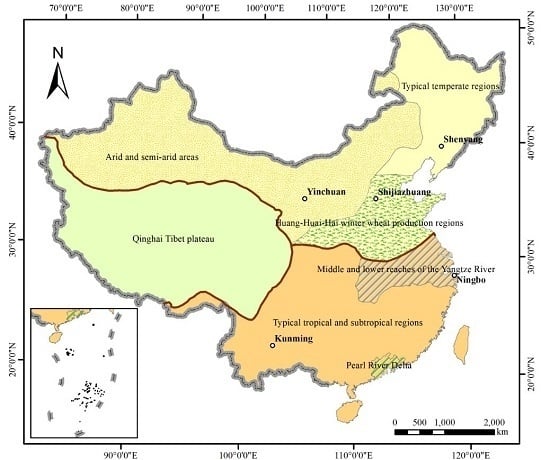Influence of Ecological Factors on Estimation of Impervious Surface Area Using Landsat 8 Imagery
Abstract
:1. Introduction
2. Impervious Surface Factors
2.1. Vegetation and Impervious Surfaces
2.2. Soil and Impervious Surfaces
2.3. Ecological Regionalization
3. Methods
3.1. Cities and Images
3.2. Linear Spectral Unmixing
3.3. Mapping of Impervious Surface Imagery
3.4. Accuracy Assessment
4. Results
4.1. Impervious Surface Fraction
4.2. Impervious Surface Estimation
4.3. Accuracy of Impervious Surface Estimations
5. Discussion
6. Conclusions
Acknowledgments
Author Contributions
Conflicts of Interest
References
- Mallick, J.; Rahman, A.; Singh, C.K. Modeling urban heat islands in heterogeneous land surface and its correlation with impervious surface area by using night-time ASTER satellite data in highly urbanizing city, Delhi-India. Adv. Space Res. 2013, 52, 639–655. [Google Scholar] [CrossRef]
- Xu, H.; Lin, D.; Tang, F. The impact of impervious surface development on land surface temperature in a subtropical city: Xiamen, China. Int. J. Climatol. 2013, 33, 1873–1883. [Google Scholar] [CrossRef]
- Wang, W.; Yao, X.; Ji, M. Integrating seasonal optical and thermal infrared spectra to characterize urban impervious surfaces with extreme spectral complexity: A Shanghai case study. J. Appl. Remote Sens. 2016. [Google Scholar] [CrossRef]
- Dams, J.; Dujardin, J.; Reggers, R.; Bashir, I.; Canters, F.; Batelaan, O. Mapping impervious surface change from remote sensing for hydrological modeling. J. Hydrol. 2013, 485, 84–95. [Google Scholar] [CrossRef]
- Miller, J.D.; Kim, H.; Kjeldsen, T.R.; Packman, J.; Grebby, S.; Dearden, R. Assessing the impact of urbanization on storm runoff in a peri-urban catchment using historical change in impervious cover. J. Hydrol. 2014, 515, 59–70. [Google Scholar] [CrossRef] [Green Version]
- Van de Voorde, T.; Jacquet, W.; Canters, F. Mapping form and function in urban areas: An approach based on urban metrics and continuous impervious surface data. Landsc. Urban Plan. 2011, 102, 143–155. [Google Scholar] [CrossRef]
- Wang, L.; Li, C.; Ying, Q.; Cheng, X.; Wang, X.; Li, X.; Hu, L.; Liang, L.; Yu, L.; Huang, H.; et al. China’s urban expansion from 1990 to 2010 determined with satellite remote sensing. Chin. Sci. Bull. 2012, 57, 2802–2812. [Google Scholar] [CrossRef]
- Jat, M.K.; Garg, P.K.; Khare, D. Monitoring and modelling of urban sprawl using remote sensing and GIS techniques. Int. J. Appl. Earth Obs. Geoinf. 2008, 10, 26–43. [Google Scholar] [CrossRef]
- Shahtahmassebi, A.R.; Song, J.; Zheng, Q.; Blackburn, G.A.; Wang, K.; Huang, L.Y.; Pan, Y.; Moore, N.; Shahtahmassebi, G.; Sadrabadi Haghighi, R.; et al. Remote sensing of impervious surface growth: A framework for quantifying urban expansion and re-densification mechanisms. Int. J. Appl. Earth Obs. Geoinf. 2016, 46, 94–112. [Google Scholar] [CrossRef]
- Weng, Q. Remote sensing of impervious surfaces in the urban areas: Requirements, methods, and trends. Remote Sens. Environ. 2012, 117, 34–49. [Google Scholar] [CrossRef]
- Patino, J.E.; Duque, J.C. A review of regional science applications of satellite remote sensing in urban settings. Comput. Environ. Urban. Syst. 2013, 37, 1–17. [Google Scholar] [CrossRef]
- Deng, C.; Wu, C. A spatially adaptive spectral mixture analysis for mapping subpixel urban impervious surface distribution. Remote Sens. Environ. 2013, 133, 62–70. [Google Scholar] [CrossRef]
- Wu, C. Normalized spectral mixture analysis for monitoring urban composition using ETM+ imagery. Remote Sens. Environ. 2004, 93, 480–492. [Google Scholar] [CrossRef]
- Powell, S.; Cohen, W.; Yang, Z.; Pierce, J.; Alberti, M. Quantification of impervious surface in the Snohomish water resources inventory area of western Washington from 1972–2006. Remote Sens. Environ. 2008, 112, 1895–1908. [Google Scholar] [CrossRef]
- Esch, T.; Himmler, V.; Schorcht, G.; Thiel, M.; Wehrmann, T.; Bachofer, F.; Conrad, C.; Schmidt, M.; Dech, S. Large-area assessment of impervious surface based on integrated analysis of single-date Landsat-7 images and geospatial vector data. Remote Sens. Environ. 2009, 113, 1678–1690. [Google Scholar] [CrossRef]
- Zhou, B.; He, H.S.; Nigh, T.A.; Schulz, J.H. Mapping and analyzing change of impervious surface for two decades using multi-temporal Landsat imagery in Missouri. Int. J. Appl. Earth Obs. Geoinf. 2012, 18, 195–206. [Google Scholar] [CrossRef]
- Lu, D.; Moran, E.; Hetrick, S. Detection of impervious surface change with multitemporal Landsat images in an urban-rural frontier. ISPRS J. Photogram. Remote Sens. 2011, 66, 298–306. [Google Scholar] [CrossRef] [PubMed]
- Ke, Y.; Im, J.; Lee, J.; Gong, H.; Ryu, Y. Characteristics of Landsat 8 OLI-derived NDVI by comparison with multiple satellite sensors and in-situ observations. Remote Sens. Environ. 2015, 164, 298–313. [Google Scholar] [CrossRef]
- Roy, D.P.; Kovalskyy, V.; Zhang, H.K.; Vermote, E.F.; Yan, L.; Kumar, S.S.; Egorov, A. Characterization of Landsat-7 to Landsat-8 reflective wavelength and normalized difference vegetation index continuity. Remote Sens. Environ. 2016, 185, 57–70. [Google Scholar] [CrossRef]
- Li, P.; Jiang, L.; Feng, Z. Cross-comparison of vegetation indices derived from Landsat-7 enhanced thematic mapper plus (ETM+) and Landsat-8 operational land imager (OLI) sensors. Remote Sens. 2013, 6, 310–329. [Google Scholar] [CrossRef]
- Poursanidis, D.; Chrysoulakis, N.; Mitraka, Z. Landsat 8 vs. Landsat 5: A comparison based on urban and peri-urban land cover mapping. Int. J. Appl. Earth Obs. Geoinf. 2015, 35, 259–269. [Google Scholar] [CrossRef]
- Xu, H.; Tang, F. Analysis of new characteristics of the first Landsat 8 image and their eco-environmental significance. Acta Ecol. Sin. 2013, 33, 3249–3257. [Google Scholar]
- Bhatti, S.S.; Tripathi, N.K. Built-up area extraction using Landsat 8 OLI imagery. GISci. Remote Sens. 2014, 51, 445–467. [Google Scholar] [CrossRef]
- Li, W.; Ouyang, Z.; Zhou, W.; Chen, Q. Effects of spatial resolution of remotely sensed data on estimating urban impervious surfaces. J. Environ. Sci. 2011, 23, 1375–1383. [Google Scholar] [CrossRef]
- Wu, C.; Yuan, F. Seasonal sensitivity analysis of impervious surface estimation with satellite imagery. Photogramm. Eng. Remote Sens. 2007, 73, 1393–1401. [Google Scholar] [CrossRef]
- Weng, Q.; Hu, X.; Lu, D. Extracting impervious surfaces from medium spatial resolution multispectral and hyperspectral imagery: A comparison. Int. J. Remote Sens. 2008, 29, 3209–3232. [Google Scholar] [CrossRef]
- Weng, Q.; Hu, X.; Liu, H. Estimating impervious surfaces using linear spectral mixture analysis with multitemporal ASTER images. Int. J. Remote Sens. 2009, 30, 4807–4830. [Google Scholar] [CrossRef]
- Sung, C.Y.; Li, M.-H. Considering plant phenology for improving the accuracy of urban impervious surface mapping in a subtropical climate regions. Int. J. Remote Sens. 2012, 33, 261–275. [Google Scholar] [CrossRef]
- Yang, J.; Li, P. Impervious surface extraction in urban areas from high spatial resolution imagery using linear spectral unmixing. Remote Sens. Appl. 2015, 1, 61–71. [Google Scholar] [CrossRef]
- Ridd, M.K. Exploring a V-I-S (vegetation-impervious surface-soil) model for urban ecosystem analysis through remote sensing: Comparative anatomy for cities. Int. J. Remote Sens. 2007, 16, 2165–2185. [Google Scholar] [CrossRef]
- Schroeder, T.A.; Cohen, W.B.; Song, C.; Canty, M.J.; Yang, Z. Radiometric correction of multi-temporal Landsat data for characterization of early successional forest patterns in western Oregon. Remote Sens. Environ. 2006, 103, 16–26. [Google Scholar] [CrossRef]
- Matthew, M.W.; Adler-Golden, S.M.; Berk, A.; Richtsmeier, S.C.; Levine, R.Y.; Bernstein, L.S.; Acharya, P.K.; Anderson, G.P.; Felde, G.W.; Hoke, M.P.; et al. Status of atmospheric correction using a MODTRAN4-based algorithm. In Proceedings of the Algorithms for Multispectral, Hyperspectral, and Ultraspectral Imagery VI, Orlando, FL, USA, 24–26 April 2000; Volume 4049, pp. 199–207. [Google Scholar]
- Kaspersen, P.; Fensholt, R.; Drews, M. Using Landsat vegetation indices to estimate impervious surface fractions for European cities. Remote Sens. 2015, 7, 8224–8249. [Google Scholar] [CrossRef] [Green Version]
- Thanapura, P.; Helder, D.L.; Burckhard, S.; Warmath, E.; O’Neill, M.; Galster, D. Mapping urban land cover using QuickBird NDVI and GIS spatial modeling for runoff coefficient determination. Photogramm. Eng. Remote Sens. 2007, 73, 57–65. [Google Scholar] [CrossRef]
- Zha, Y.; Gao, J.; Ni, S. Use of normalized difference built-up index in automatically mapping urban areas from TM imagery. Int. J. Remote Sens. 2003, 24, 583–594. [Google Scholar] [CrossRef]
- Kawamura, M.; Jayamana, S.; Tsujiko, Y. Relation between social and environmental conditions in Colombo Sri Lanka and the urban index estimated by satellite remote sensing data. Int. Arch. Photogramm. Remote Sens. 1996, 31, 321–326. [Google Scholar]
- Xu, H.; Du, L. Fast extraction of built-up land information from remote sensing imagery. J. Geo-Inf. Sci. 2010, 12, 574–579. [Google Scholar] [CrossRef]
- Deng, C.; Wu, C. BCI: A biophysical composition index for remote sensing of urban environments. Remote Sens. Environ. 2012, 127, 247–259. [Google Scholar] [CrossRef]
- Xu, H. Analysis of impervious surface and its impact on urban heat environment using the normalized difference impervious surface index (NDISI). Photogramm. Eng. Remote Sens. 2010, 76, 557–565. [Google Scholar] [CrossRef]
- Sexton, J.O.; Song, X.; Huang, C.; Channan, S.; Baker, M.E.; Townshend, J.R. Urban growth of the Washington, D.C.–Baltimore, MD metropolitan region from 1984 to 2010 by annual Landsat-based estimates of impervious cover. Remote Sens. Environ. 2013, 129, 42–53. [Google Scholar] [CrossRef]
- Song, X.-P.; Sexton, J.O.; Huang, C.; Channan, S.; Townshend, J.R. Characterizing the magnitude, timing and duration of urban growth from time series of Landsat-based estimates of impervious cover. Remote Sens. Environ. 2016, 175, 1–13. [Google Scholar] [CrossRef]
- Wu, C.; Murray, A.T. Estimating impervious surface distribution by spectral mixture analysis. Remote Sens. Environ. 2003, 84, 493–505. [Google Scholar] [CrossRef]
- Franke, J.; Roberts, D.A.; Halligan, K.; Menz, G. Hierarchical multiple endmember spectral mixture analysis (MESMA) of hyperspectral imagery for urban environments. Remote Sens. Environ. 2009, 113, 1712–1723. [Google Scholar] [CrossRef]
- Green, A.A.; Berman, M.; Switzer, P.; Craig, M.D. A transformation for ordering multispectral data in terms of image quality with implications for noise removal. IEEE Trans. Geosci. Remote Sens. 1988, 26, 65–74. [Google Scholar] [CrossRef]
- Zhang, J.; He, C.; Zhou, Y.; Zhu, S.; Shuai, G. Prior-knowledge-based spectral mixture analysis for impervious surface mapping. Int. J. Appl. Earth Obs. Geoinf. 2014, 28, 201–210. [Google Scholar] [CrossRef]
- Xiao, R.; Ouyang, Z.; Cai, Y.; Li, W. Urban landscape pattern study based on sub-pixel estimation of impervious surface. Acta Ecol. Sin. 2007, 27, 3189–3197. [Google Scholar]
- Flanagan, M.; Civco, D.L. Subpixel impervious surface mapping. In Proceedings of the 2001 ASPRS Annual Convention, St. Louis, MO, USA, 23–27 April 2001. [Google Scholar]
- Li, L.; Lu, D.; Kuang, W. Examining urban impervious surface distribution and its dynamic change in Hangzhou metropolis. Remote Sens. 2016, 8, 265. [Google Scholar] [CrossRef]
- Aguilar, M.A.; Nemmaoui, A.; Aguilar, F.J.; Novelli, A.; García Lorca, A. Improving georeferencing accuracy of Very High Resolution satellite imagery using freely available ancillary data at global coverage. Int. J. Digital Earth. 2017, 1–15. [Google Scholar] [CrossRef]
- Zhang, Y.; Zhang, H.; Lin, H. Improving the impervious surface estimation with combined use of optical and SAR remote sensing images. Remote Sens. Environ. 2014, 141, 155–167. [Google Scholar] [CrossRef]
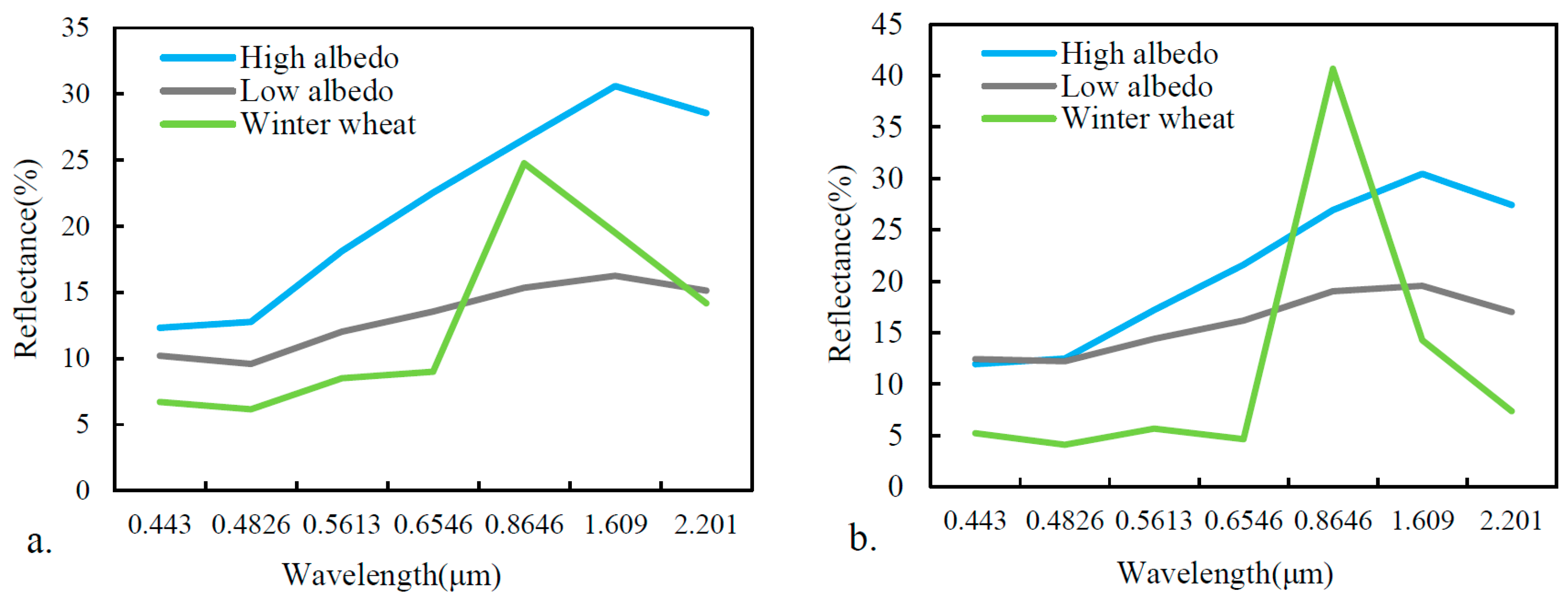
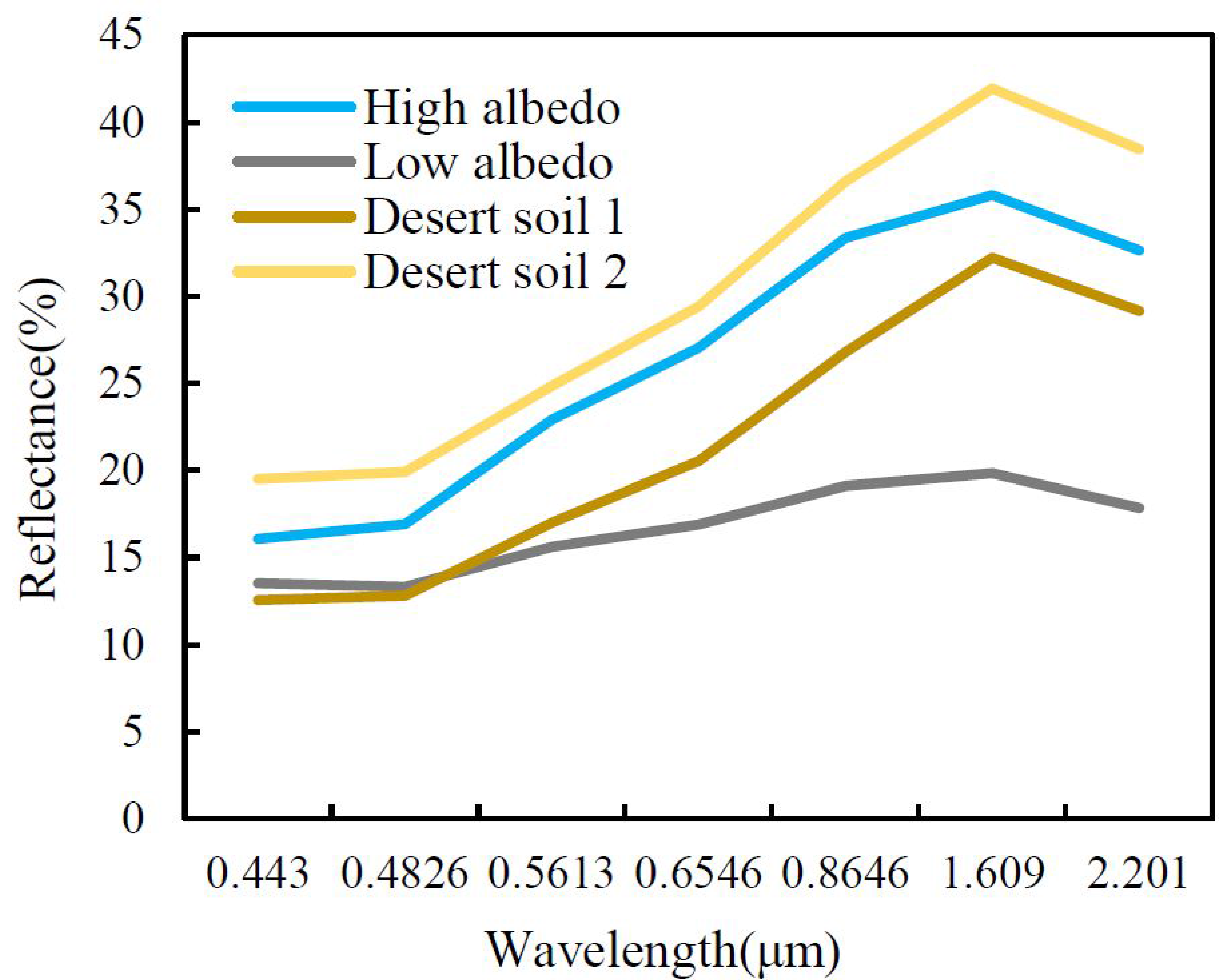
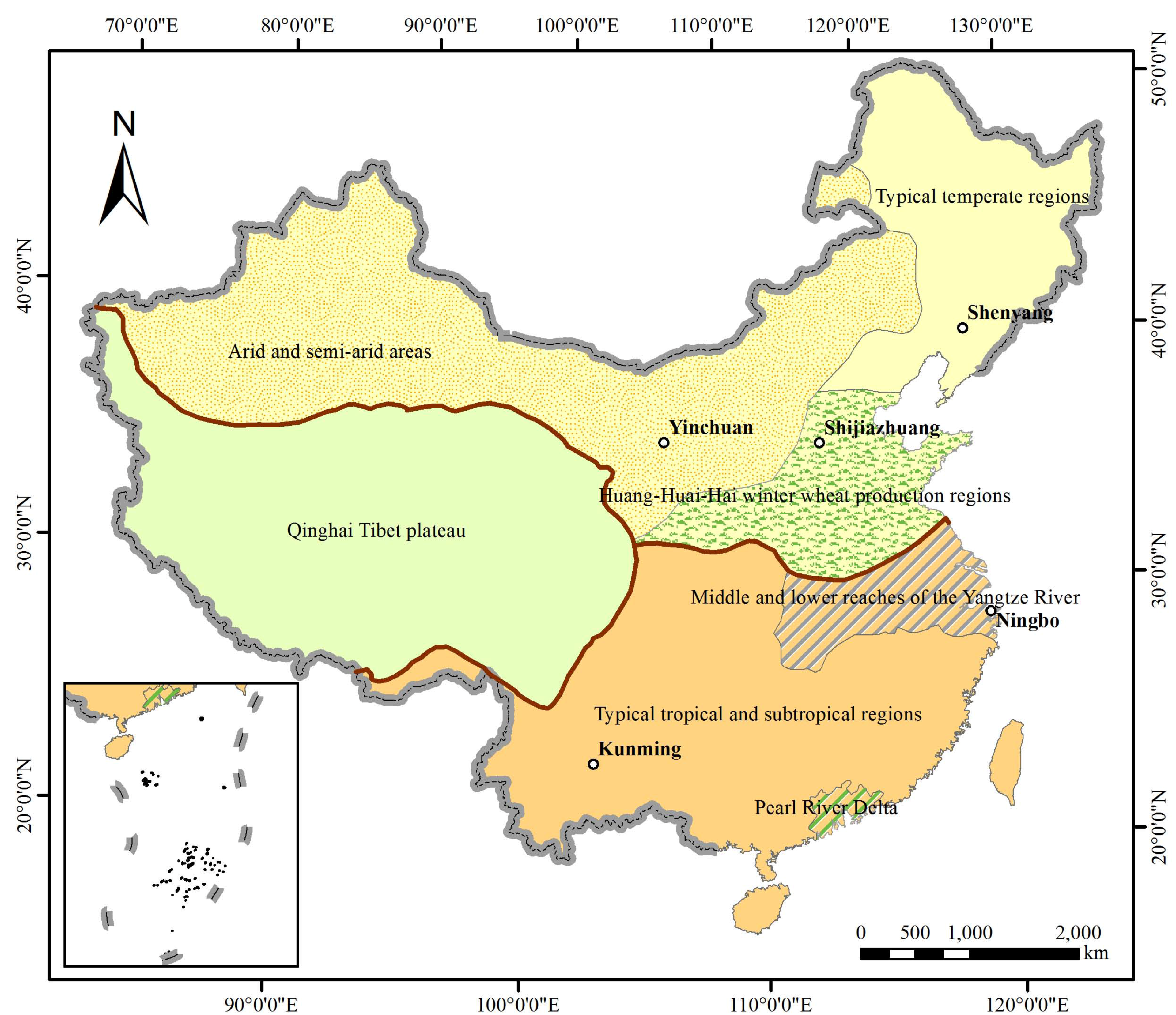
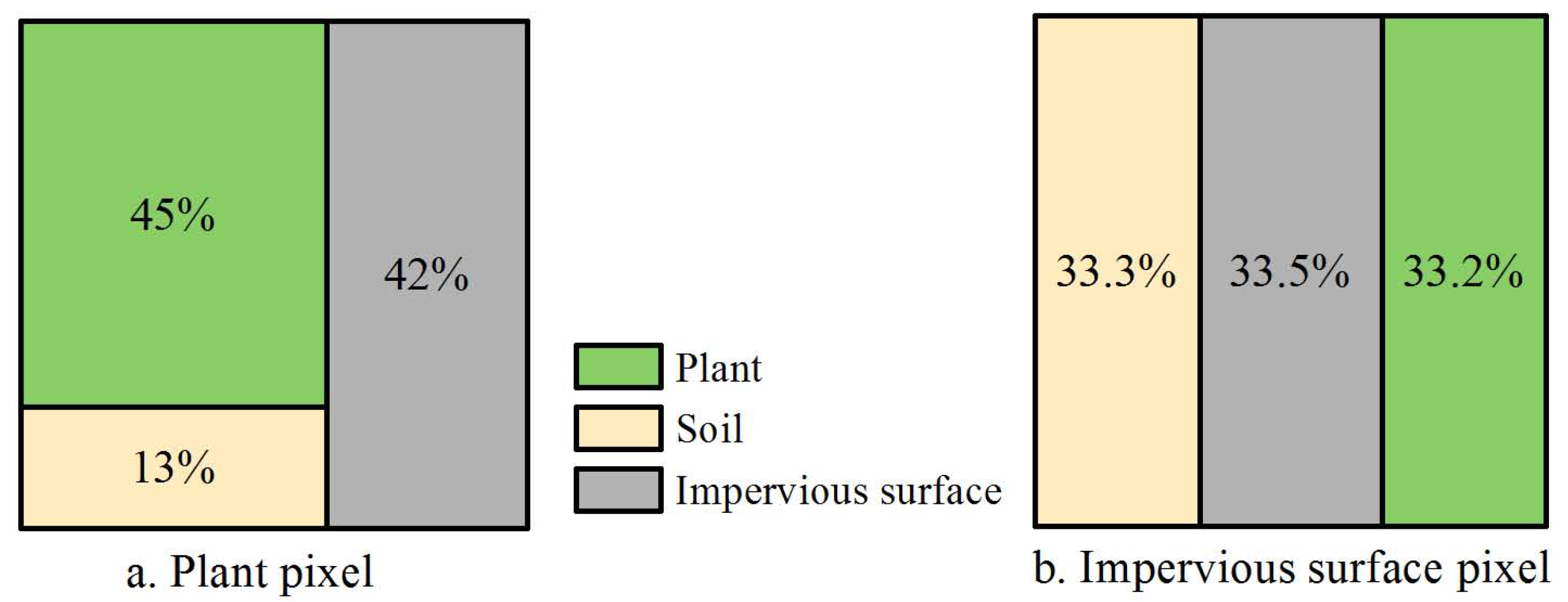
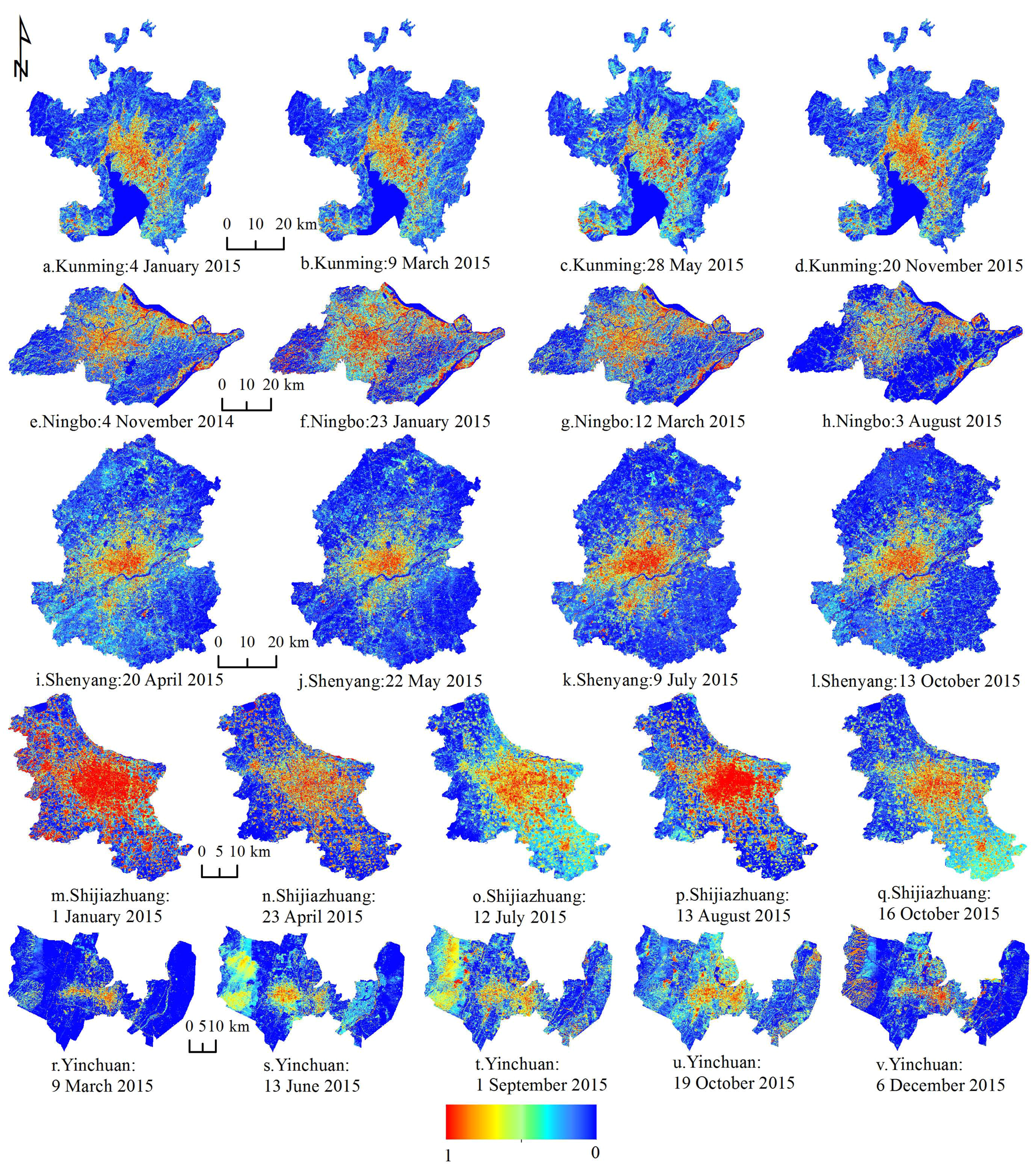
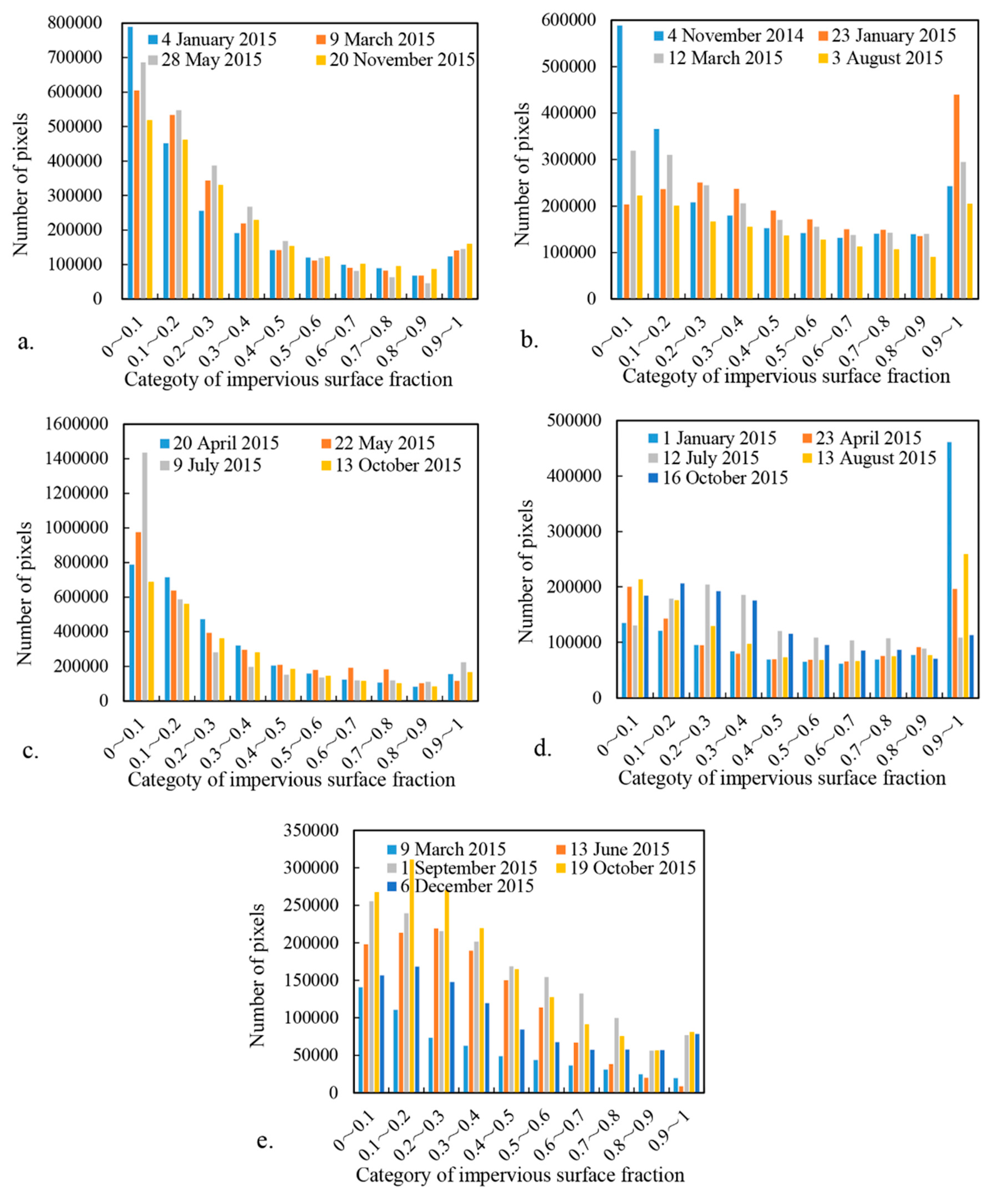
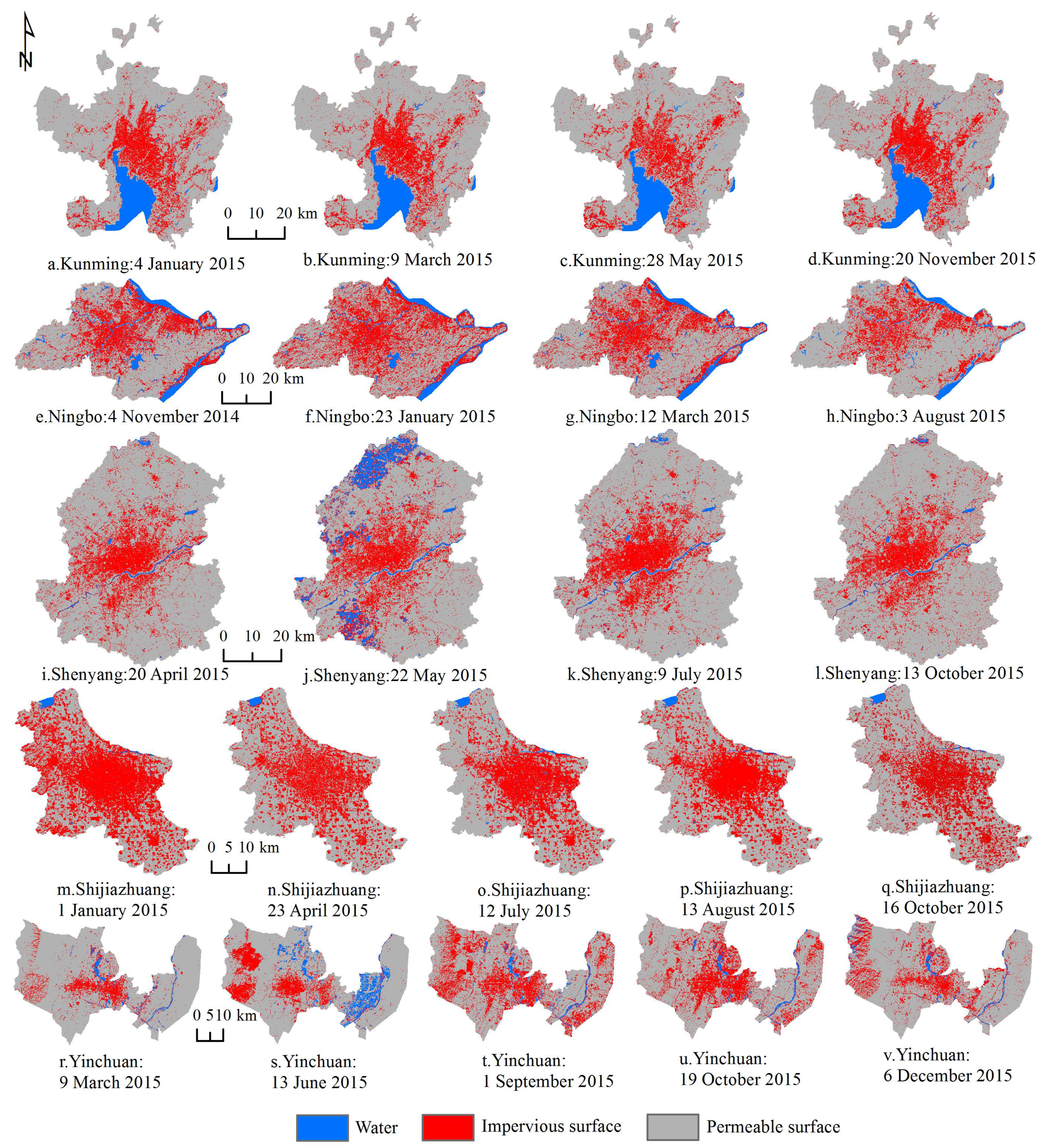
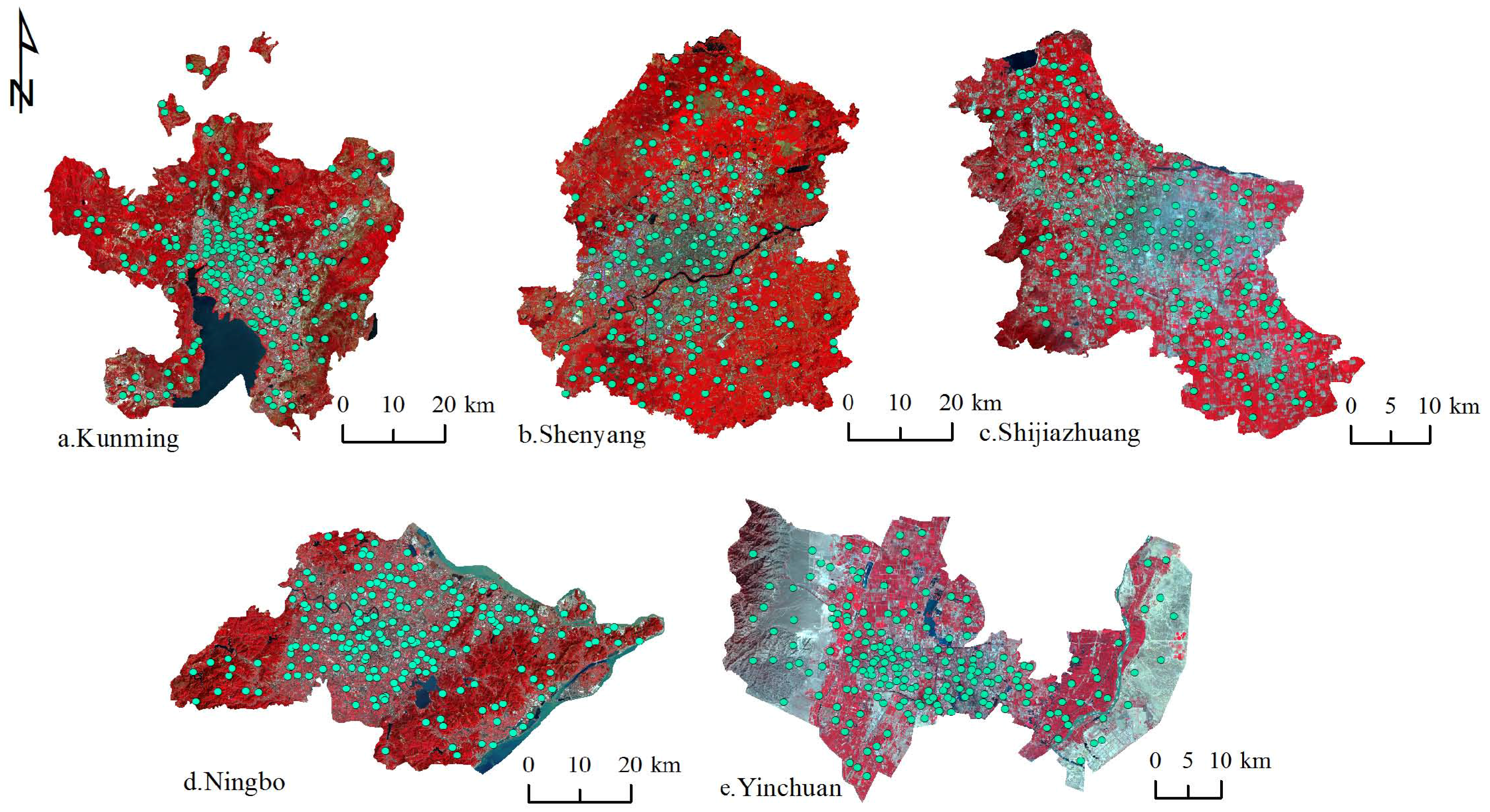
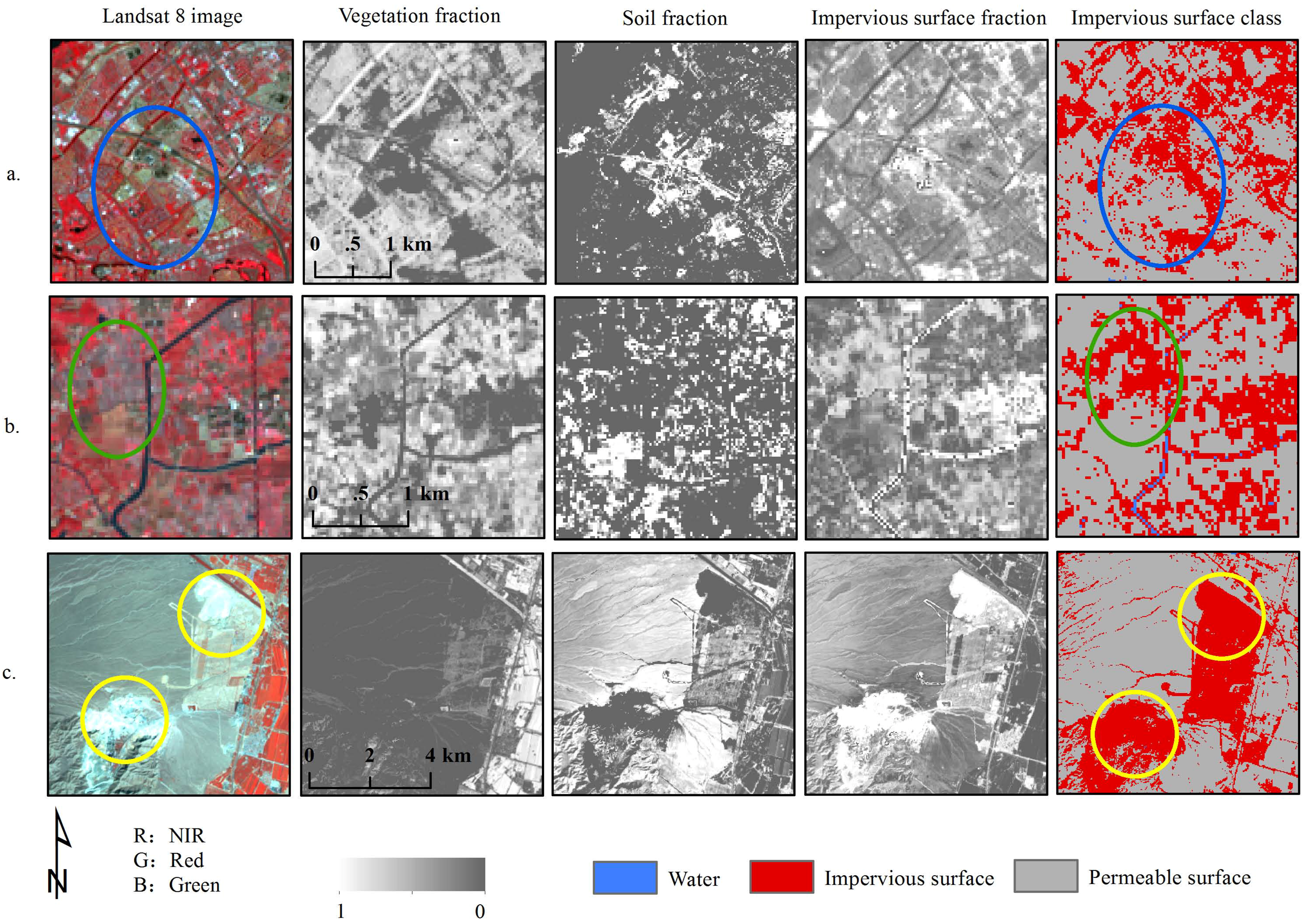
| City | Indicated Ecological Sub-Regions | Main Factors | Date |
|---|---|---|---|
| Kunming | Typical tropical and subtropical regions | Vegetation canopy | 4 January 2015, 9 March 2015, 28 May 2015, 20 November 2015 |
| Ningbo | The Pearl River Delta, the middle and lower reaches of the Yangtze River | Soil, vegetation phenology, vegetation canopy, and water | 4 November 2014, 23 January 2015, 12 March 2015, 3 August 2015 |
| Shenyang | Typical temperate regions | Vegetation phenology | 20 April 2015, 22 May 2015, 9 July 2015, 13 October 2015 |
| Shijiazhuang | The Huang-Huai-Hai winter wheat production regions | Vegetation phenology | 1 January 2015, 23 April 2015, 12 July 2015, 13 August 2015, 16 October 2015 |
| Yinchuan | Arid and semi-arid areas | Vegetation phenology and dry soil | 9 March 2015, 13 June 2015, 1 September 2015, 19 October 2015, 6 December 2015 |
| City | Date and Pixel Number | Variation Coefficient | ||||
|---|---|---|---|---|---|---|
| Kunming | 4 January 2015 | 9 March 2015 | 28 May 2015 | 20 November 2015 | 5.98% | |
| 559,616 | 552,432 | 529,928 | 609,758 | |||
| Ningbo | 4 November 2014 | 23 January 2015 | 12 March 2015 | 3 August 2015 | 19.9% | |
| 816,068 | 1,074,375 | 908,824 | 685,626 | |||
| Shenyang | 20 April 2015 | 22 May 2015 | 9 July 2015 | 13 October 2015 | 7.9% | |
| 724,567 | 845,535 | 778,695 | 713,090 | |||
| Shijiazhuang | 1 January 2015 | 23 April 2015 | 12 July 2015 | 13 August 2015 | 16 October 2015 | 18.94% |
| 768,737 | 534,187 | 529,869 | 548,595 | 499,412 | ||
| Yinchuan | 9 March 2015 | 13 June 2015 | 1 September 2015 | 19 October 2015 | 6 December 2015 | 34.31% |
| 227,992 | 335,412 | 575,642 | 494,436 | 361,726 | ||
| City | Index | Date of Image | ||||
|---|---|---|---|---|---|---|
| Kunming | 4 January 2015 | 9 March 2015 | 28 May 2015 | 20 November 2015 | ||
| PA (%) | 92.86 | 87.8 | 78.31 | 82.52 | ||
| UA (%) | 81.25 | 82.29 | 67.71 | 88.54 | ||
| OA (%) | 88 | 86 | 75.5 | 85.5 | ||
| Ningbo | 4 November 2014 | 23 January 2015 | 12 March 2015 | 3 August 2015 | ||
| PA (%) | 80.95 | 72.65 | 78.30 | 85.71 | ||
| UA (%) | 90.43 | 90.43 | 88.3 | 82.98 | ||
| OA (%) | 85.5 | 79.5 | 83 | 85.5 | ||
| Shenyang | 20 April 2015 | 22 May 2015 | 9 July 2015 | 13 October 2015 | ||
| PA (%) | 92.75 | 87.67 | 94.59 | 95.95 | ||
| UA (%) | 68.09 | 68.09 | 74.47 | 75.53 | ||
| OA (%) | 82.5 | 80.5 | 86 | 87 | ||
| Shijiazhuang | 1 January 2015 | 23 April 2015 | 12 July 2015 | 13 August 2015 | 16 October 2015 | |
| PA (%) | 80.36 | 90.7 | 89.25 | 92.31 | 88.76 | |
| UA (%) | 95.74 | 82.98 | 88.3 | 89.36 | 84 | |
| OA (%) | 87 | 88 | 89.5 | 91.5 | 87.5 | |
| Yinchuan | 9 March 2015 | 13 June 2015 | 1 September 2015 | 19 October 2015 | 6 December 2015 | |
| PA (%) | 78 | 70.97 | 70 | 75.27 | 64.29 | |
| UA (%) | 48.75 | 50 | 87.5 | 87.5 | 45 | |
| OA (%) | 74 | 73 | 80 | 83.5 | 68 | |
© 2017 by the authors. Licensee MDPI, Basel, Switzerland. This article is an open access article distributed under the terms and conditions of the Creative Commons Attribution (CC BY) license (http://creativecommons.org/licenses/by/4.0/).
Share and Cite
Jia, Y.; Tang, L.; Wang, L. Influence of Ecological Factors on Estimation of Impervious Surface Area Using Landsat 8 Imagery. Remote Sens. 2017, 9, 751. https://doi.org/10.3390/rs9070751
Jia Y, Tang L, Wang L. Influence of Ecological Factors on Estimation of Impervious Surface Area Using Landsat 8 Imagery. Remote Sensing. 2017; 9(7):751. https://doi.org/10.3390/rs9070751
Chicago/Turabian StyleJia, Yuqiu, Lina Tang, and Lin Wang. 2017. "Influence of Ecological Factors on Estimation of Impervious Surface Area Using Landsat 8 Imagery" Remote Sensing 9, no. 7: 751. https://doi.org/10.3390/rs9070751




